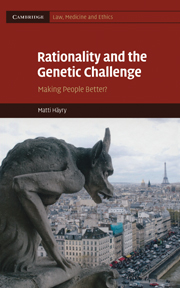Book contents
- Frontmatter
- Contents
- Preface
- 1 Seven ways of making people better
- 2 Rational approaches to the genetic challenge
- 3 The best babies and parental responsibility
- 4 Deaf embryos, morality, and the law
- 5 Saviour siblings and treating people as a means
- 6 Reproductive cloning and designing human beings
- 7 Embryonic stem cells, vulnerability, and sanctity
- 8 Gene therapies, hopes, and fears
- 9 Considerable life extension and the meaning of life
- 10 Taking the genetic challenge rationally
- Bibliography
- Index
5 - Saviour siblings and treating people as a means
Published online by Cambridge University Press: 05 July 2014
- Frontmatter
- Contents
- Preface
- 1 Seven ways of making people better
- 2 Rational approaches to the genetic challenge
- 3 The best babies and parental responsibility
- 4 Deaf embryos, morality, and the law
- 5 Saviour siblings and treating people as a means
- 6 Reproductive cloning and designing human beings
- 7 Embryonic stem cells, vulnerability, and sanctity
- 8 Gene therapies, hopes, and fears
- 9 Considerable life extension and the meaning of life
- 10 Taking the genetic challenge rationally
- Bibliography
- Index
Summary
In this chapter, I analyse the morality of creating children who could become tissue donors for their older siblings. After an examination of harms, benefits, consent, and privacy, I study in detail the argument that the production of saviour siblings involves, wrongfully, the treatment of people as mere means.
Facts and regulations
When parents need a matching donor for a seriously ill child, they can try to produce one by using reproductive technologies. Preimplantation genetic diagnosis (PGD) following in vitro fertilisation (IVF) reveals an embryo’s immune – human leucocyte antigen (HLA) – profile and whether or not it could become a suitable donor for its existing sibling. In a favourable case, a healthy and matching embryo can be implanted in the potential mother’s uterus and if all goes well, a suitable donor is born. Stem cells are retrieved by collecting placental or umbilical cord blood and these are injected into the ailing child in the hope of providing a cure. Donation of blood, bone marrow, and organs is also a viable option for other treatments that may be required later.
The conditions for which healthy matching donors have been sought so far include Fanconi’s anaemia, thalassaemia, and Diamond–Blackfan anaemia (DBA), all diseases with bleak prognoses if stem cell therapies enabled by saviour siblings cannot be used. Fanconi’s anaemia causes shortness, skeletal anomalies, tumours, leukaemias, and bone marrow failure; some forms of thalassaemia require constant heavy medication and regular blood transfusions; and DBA is associated with congenital malformations, thumb and upper limb abnormalities, cardiac defects, urogenital deformities, and cleft palate. Successful treatments have been reported at least in the United States, in the United Kingdom, and Belgium. Widely reported cases in the saviour sibling discussion are those of the Nash family in Colorado, United States (the first saviour sibling, provided a successful cure for Fanconi’s anaemia in 2000); in Great Britain, the Hashmi family (legal battle to produce a saviour sibling for thalassaemia (2000–2005), family stopped trying in 2004); the Whitaker family (travelled to Chicago in 2002 to produce a matching donor for DBA); and the Fletcher family (the first British saviour sibling, donor for DBA, born in 2005).
- Type
- Chapter
- Information
- Rationality and the Genetic ChallengeMaking People Better?, pp. 99 - 123Publisher: Cambridge University PressPrint publication year: 2010

